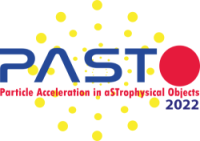Conveners
Galactic Astrophysical Accelerators
- Barbara Olmi (Istituto Nazionale di Astrofisica (INAF))
Galactic Astrophysical Accelerators
- Barbara Olmi (Istituto Nazionale di Astrofisica (INAF))
Galactic Astrophysical Accelerators
- Martina Cardillo (INAF- IAPS)
Galactic Astrophysical Accelerators
- Lucio Angelo Antonelli (Istituto Nazionale di Astrofisica (INAF))
In this talk I will summarize the status of the century long quest for the sources of Galactic Cosmic Rays. I will discuss recent challenges to the paradigm associating Galactic Cosmic Rays to acceleration in Supernova Remnants, and then introduce alternative classes of sources, such as star forming regions and Pulsar Wind Nebulae, that are gaining increasing attention thanks to highlights...
Gamma-ray binaries, which consist of a compact object and a star, are galactic non-thermal sources that present radiation from radio to gamma rays, and a rich phenomenology largely affected by the system binarity. Of particular interest are gamma-ray binaries hosting massive stars, as they are among the most powerful and efficient galactic persistent accelerators. The most common scenario for...
The very-high-energy gamma-ray emission observed from a number of Supernova remnants (SNRs) indicates particle acceleration to high energies at the shock of the remnants and a potentially significant contribution to Galactic cosmic rays. It is extremely difficult to determine whether protons (through hadronic interactions and subsequent pion decay) or electrons (through inverse Compton...
Hadronic γ-ray sources associated with supernova remnants (SNRs) can serve as stopwatches for the escape of cosmic rays (CRs) from SNRs, which gradually develops from highest-energy particles to lowest-energy particles with time. In this work, we analyze the 13.7 yr Fermi-LAT data to investigate the γ-ray feature in/around the SNR G298.6−0.0 region. With ≥16 GeV data, we detect two spatial...
The detection of a diffuse flux of cosmic neutrinos with energies up to several PeV has opened a new window into the exploration of the extreme non-thermal Universe. Despite several analysis strategies have been implemented, the origin of these neutrinos remains to date unknown. The latter include the investigation of catalogued astrophysical accelerators as well as neutrino auto-correlation...
Elongated X-ray features have been detected in association to some bow-shock pulsar wind nebulae, among which those of PSR B224+65 (the Guitar Nebula), PSR J1101-6101 (the Lighthouse Nebula), PSR B0355+54, PSR J1135-6055, PSR J1509-5850, PSR J2055+2539, PSR J1809-1917 and more recently the outstanding filament associated to PSR J2030+4415.
Distinctive properties of these features are: a very...
Supernova remnants (SNRs) are known to accelerate particles to relativistic energies, from the detection of nonthermal emission. The particularities of the acceleration mechanism are still debated. Here, we discuss how particle escape modifies the observable spectra as well as morphological features that might be revealed by the observational progress from radio to gamma-ray energies.
We use...
Young supernova remnants (SNRs) such as Cas A, Tycho, and SN1006 are relativistic particle accelerators and likely the sources of most of Galactic cosmic rays.
The X-ray synchrotron emission from their shock fronts has been expected to be polarized for some time.
The measurement of X-ray polarization degree and direction provides unique constraints on the turbulence level of the magnetic...
Both radio and gamma astronomy are about to hugely profit from new and upcoming instruments. SKA and CTA precursors and pathfinder are going to give us an unprecedented view of our Galaxy in the two most extreme parts of the electromagnetic spectrum. Supernova remnants (SNRs) are emblematic sources where the radio emission mirrors the energy distribution of the accelerated particles.
In this...
Novae, among the brightest transients in the night sky, are luminous eruptions occurring in a binary system in which a white dwarf accretes mass from a stellar companion. As an accreted layer accumulates conditions are reached for a thermonuclear runaway. The resulting energy release causes the accreted envelope to expand, leading to its ejection. During this process shock waves are produced...
Supernovae remnants (SNRs) are widely believed to be one of the prime sources of Galactic cosmic rays. They are known to be efficient particle accelerators which is indirectly confirmed by detection of non-thermal emission across the whole electromagnetic spectrum from radio to very-high-energy gamma-rays. Protons and electrons can be accelerated to very high energies of at least several tens...

